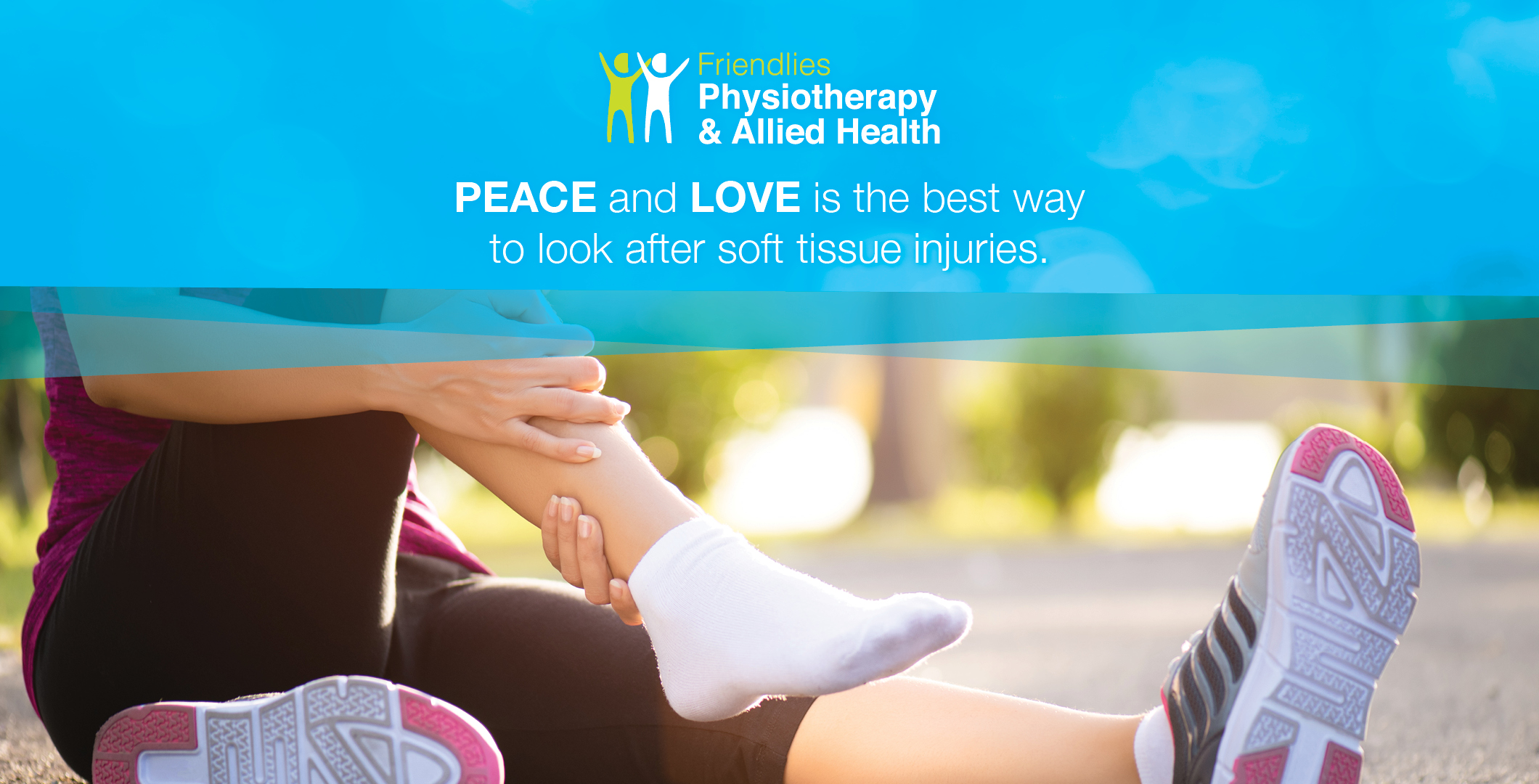
RICER or PEACE and LOVE for Acute Soft Tissue Injuries
Treatment of soft tissue injuries including muscle, ligament and tendon has always attracted a lot of attention; and a lot of ice packs! Recent research has shown that there may be a better way to look after these injuries. You may remember RICER (rest, ice, compression, elevation and referral) and No HARM (no -heat, -alcohol, -re-injury and -massage).
RICER is still a good tool to use, but it has got a bit of an update and a bit of a 70’s twist with “PEACE and LOVE.”
PEACE:
P for Protect
Firstly, start by doing no HARM – so no heat, alcohol, re-injury (avoid significant aggravation) and massage.
Unload or restrict movement for 1–3 days to minimise bleeding, prevent stretching of injured fibres and reduce the risk of aggravating the injury. Taping or bracing can help you get around more comfortably while still protecting the injured area. Rest should be minimised as prolonged rest can reduce tissue strength and quality. Pain signals or your health professional should guide you when you can reduce how much you protect.
E for elevate
Elevate the limb higher than the heart to promote fluid flow out of tissues and slow the rate of swelling around the injury.
A for Avoid anti-inflammatories if possible
The various phases of inflammation help repair damaged soft tissues. Reducing inflammation using medications may negatively affect tissue healing, especially when higher dosages are used. We recommend using paracetamol for pain relief first and only use anti-inflammatories if the injury is still too sore to sleep or get around. Ice can also be used for pain relief but doesn’t help the healing of the tissues.
C for compress
External pressure using taping or bandages helps limit too much swelling in the joint and bleeding (which leads to bruising). Compression after an ankle sprain helps reduce swelling and improve the quality of life in most cases. We often use taping in the early stages to protect and compress the injury, helping you build confidence, get you moving a little earlier without worsening the injury.
E for educate
Any time you have an injury, no matter what type, it’s important to understand what’s going on. That often starts by talking to a Physiotherapist and getting an idea of what you’ve injured. When you used to go to the Physiotherapist, you may have got electrotherapy or ultrasound but these modalities don’t help your tissues heal. The research indicates you’re better off learning how to manage things yourself, nurturing your body as it heals, following PEACE and LOVE.
After the first days have passed, soft tissues need LOVE.
LOVE:
L for load
An active approach with movement and exercise benefits most patients with musculoskeletal disorders. Loading your injury should usually start 48-72 hours after your injury and normal activities resumed as soon as symptoms allow. Putting the optimal amount of load on an injury without exacerbating too much pain promotes repair, remodelling and builds tissue tolerance and the capacity of tendons, muscles and ligaments. If you aren’t sure how much pressure you should put on your injury, you should speak to your Physiotherapist.
O for optimism
If you can have a positive outlook on your injury and trust that your body will heal, you are more likely to let the healing take place without over-protecting or over-treating the injury. If you’re finding it hard to stay positive about your injury due to fear, anxiety or depression, it’s important to talk to your Physiotherapist or Doctor and gain confidence from their advice. They will give strategies that will help keep you on track.
V for vascularisation
Cardiovascular activity – an activity that gets you a little breathless – is really important when managing musculoskeletal injuries. We don’t know exactly how much you need to do, but pain-free aerobic exercise should be started a few days after injury to boost motivation and increase blood flow to the injured structures. Early movement and aerobic exercise improve physical function, supports a return to work and play, and can reduce the need for pain medication.
E for exercise
There is a lot of evidence supporting the use of exercise for the treatment of ankle sprains and for reducing the prevalence of recurrent injuries. Exercises help to restore mobility, strength and body awareness early after injury. Pain should be minimised to ensure good repair during the early phases of recovery and should be used as a guide for exercise progressions. Physiotherapists are well trained to provide guidance on progressive exercises and on returning to your normal activities.